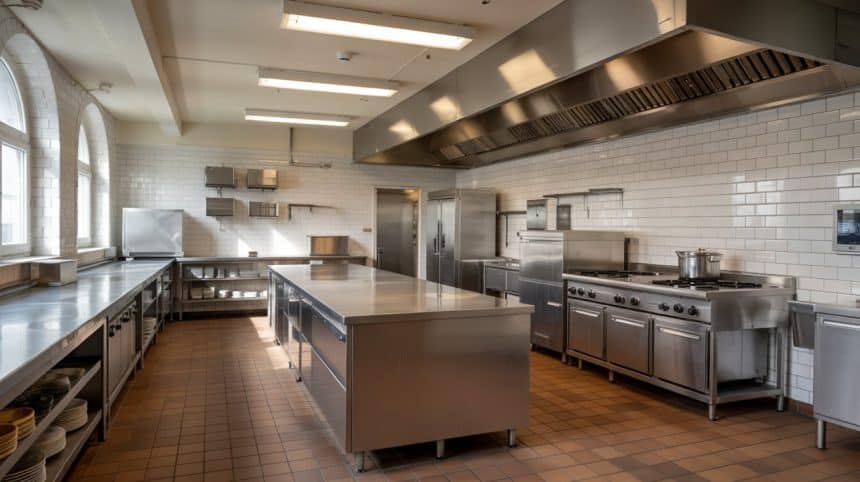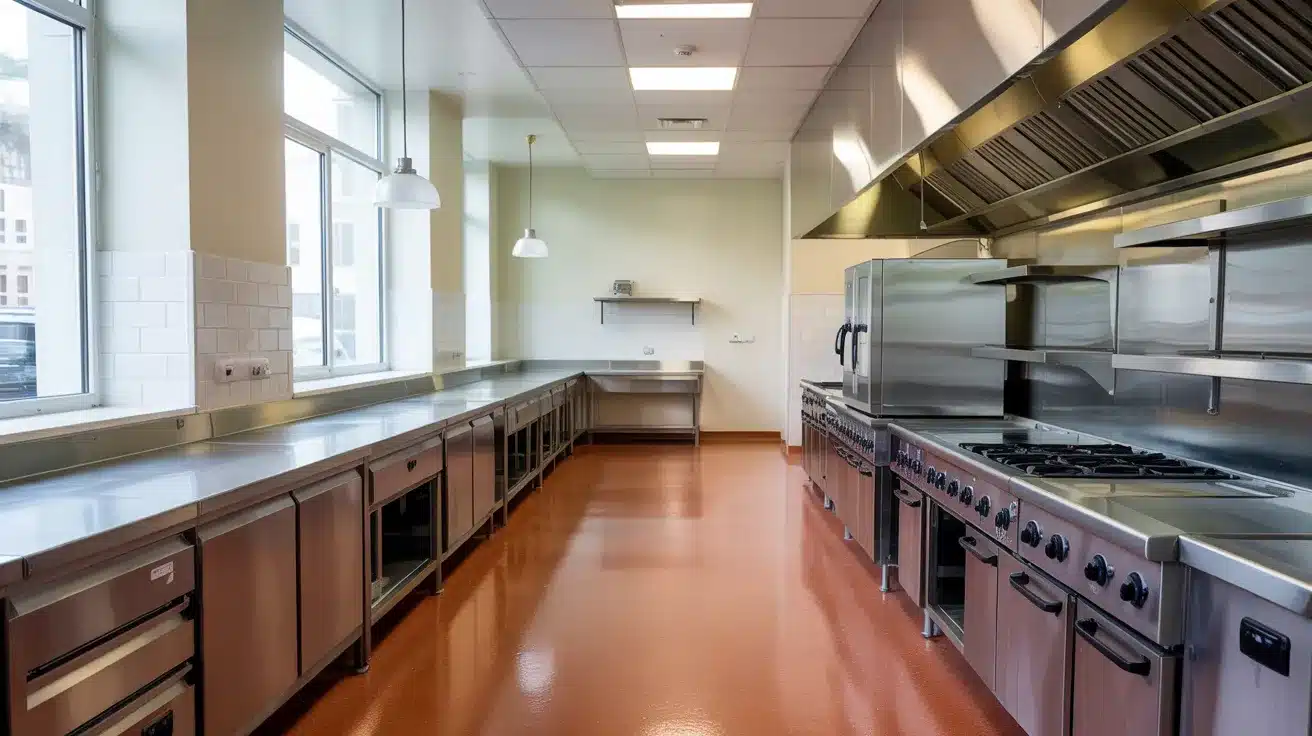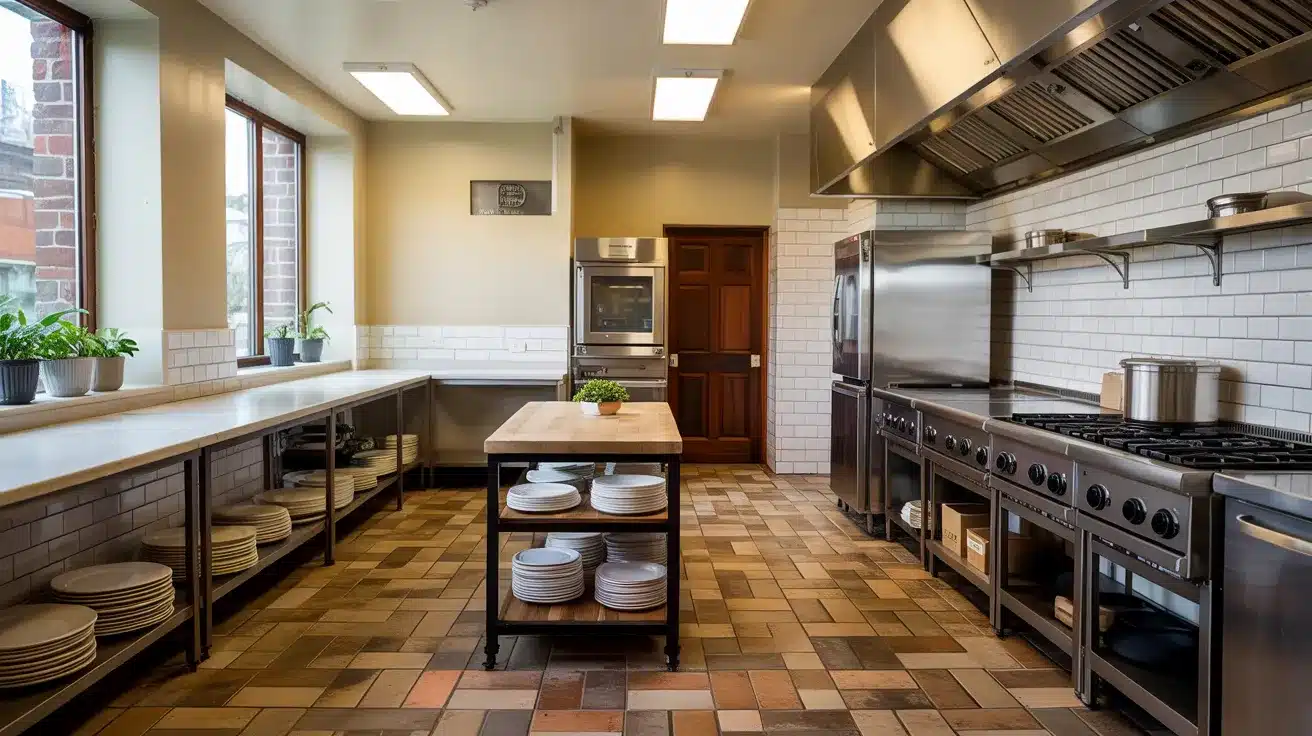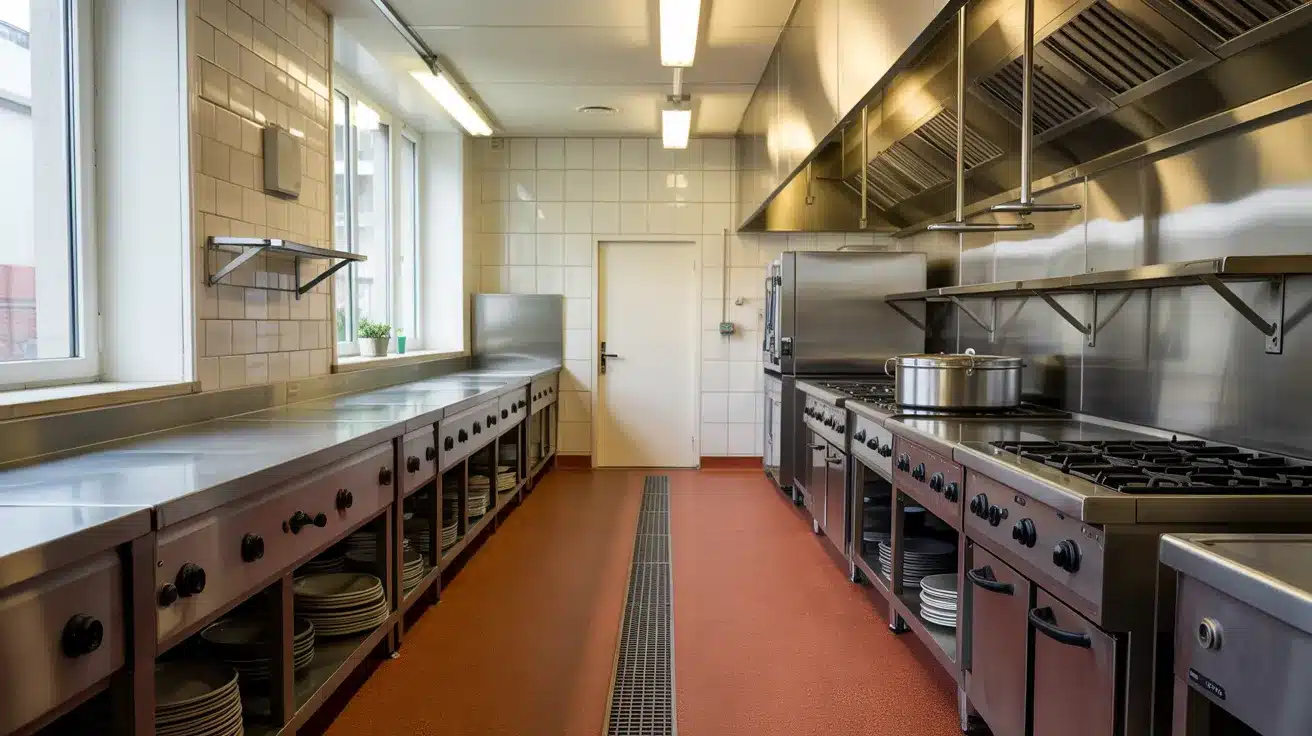Finding the right commercial kitchen flooring can make or break your food service business. Daily spills, high heat, foot traffic, and strict health codes all call for a floor that won’t let you down.
Your kitchen floor affects staff safety, cleaning time, and even health inspection results. With numerous options available on the market, selecting the best fit requires careful consideration of what matters most in your specific space.
This guide walks you through the top flooring choices for commercial kitchens, from budget-friendly vinyl to long-lasting quarry tile. We’ll cover what makes each option stand out, what drawbacks to watch out for, and how to match your needs with the right surface.
By the end, you’ll have the facts you need to choose a floor that serves your kitchen well for years to come.
What is Commercial Kitchen Flooring?
Commercial kitchen flooring is a specialized surface designed for food preparation areas in restaurants, hotels, and other food-related businesses. These floors need to handle heavy foot traffic, food spills, and the constant movement of large equipment.
Unlike home kitchens, commercial spaces face much tougher daily challenges. Staff work for hours on these floors, often moving heavy pots and carrying trays. The floors must stay clean and safe despite grease, water, and food particles that fall throughout busy shifts.
Good commercial flooring helps keep staff safe from slips and falls. It also makes cleaning easier, which is key for passing health inspections. The right floor can save money over time by lasting longer and needing fewer repairs.
Proper flooring is not just a building detail—it’s a basic need for any food business that wants to run well and meet safety rules.
Most Recommended Flooring Types for Commercial Kitchens
Choosing the right flooring is crucial for maintaining safety, hygiene, and durability in a high-traffic commercial kitchen. Here are the top-performing options you should consider.
1. Epoxy Flooring
Epoxy flooring creates a smooth, sealed surface that works well in high-traffic areas, such as busy kitchens. The liquid coating bonds to concrete floors, forming a strong barrier against stains and damage. Your staff will notice fewer slips thanks to its grip-friendly finish.
Why choose epoxy:
- No seams means fewer places for germs to hide
- Stands up to heavy use for many years
- Water and spills stay on the surface for quick cleanup
- Special finishes add grip to prevent falls
Things to consider:
- You’ll need experts to put it in
- The floor must be fully clean and dry before coating
2. Quarry Tile
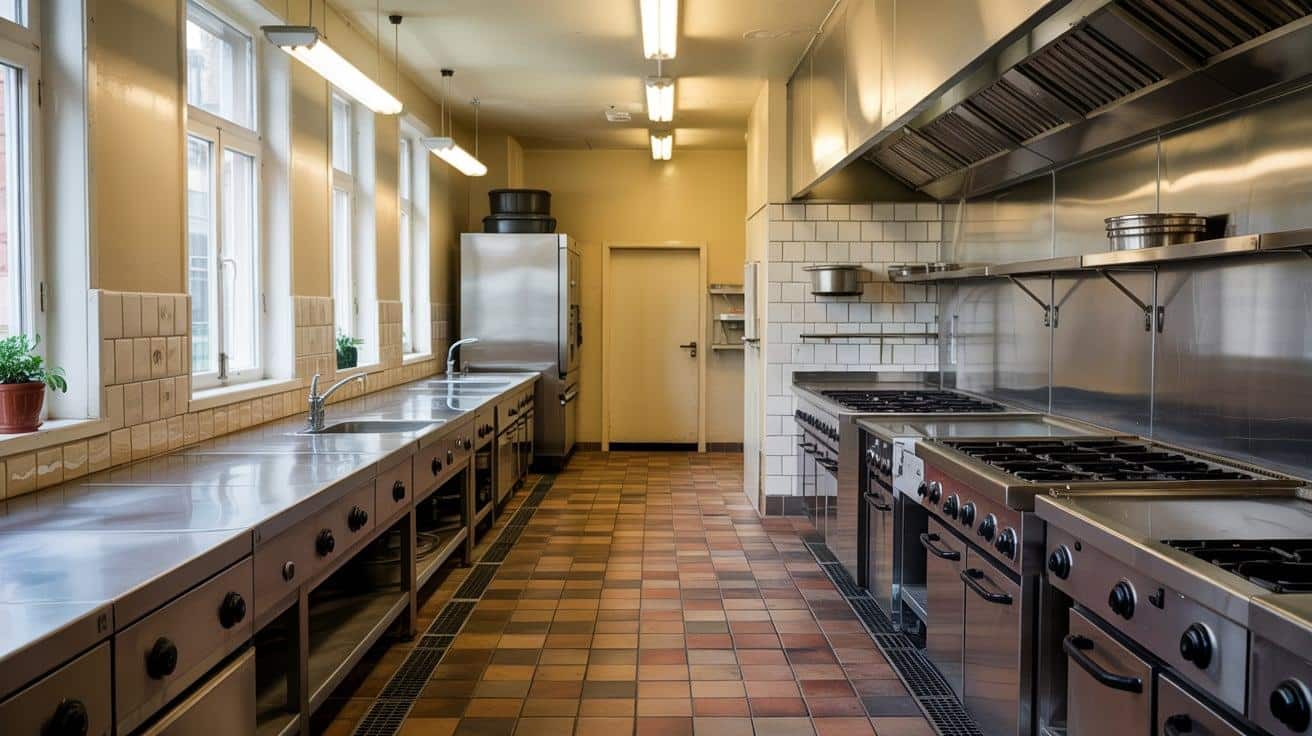
Quarry tile has been a kitchen standard for years because it handles heat and heavy use so well. The thick, clay-based tiles come in shades of red-brown and create a classic look that many chefs prefer.
Why choose quarry tile:
- Gives a good grip even when wet
- Hot pans won’t damage the surface
- It can last for decades with proper care
- Withstands harsh cleaning chemicals
Things to consider:
- Standing on it all day can cause leg fatigue
- Grout lines need regular scrubbing to stay clean
3. Vinyl (LVT or Sheet Vinyl)
Vinyl offers a balance of comfort and function at a good price. You can choose between sheets (with minimal seams) or luxury vinyl tiles that look like stone or wood but perform better in kitchen settings.
Why choose vinyl:
- Feels softer underfoot than hard tiles
- Water can’t soak through it
- Costs less than many other options
- Quick to install with less downtime
Things to consider:
- Heavy equipment might leave marks
- May need replacement sooner in very busy kitchens
4. Rubber Flooring
Rubber flooring helps reduce staff fatigue and kitchen noise. The bouncy material comes in tiles or sheets and provides good traction that many cooks and servers value during long shifts.
Why choose rubber:
- Feels soft and reduces leg strain
- Stays grippy even when wet
- Cuts down on noise from pots and pans
- Comes in many colors and patterns
Things to consider:
- Hot oil can damage some rubber types
- Heavy rolling racks might leave marks over time
5. Concrete (Sealed or Polished)
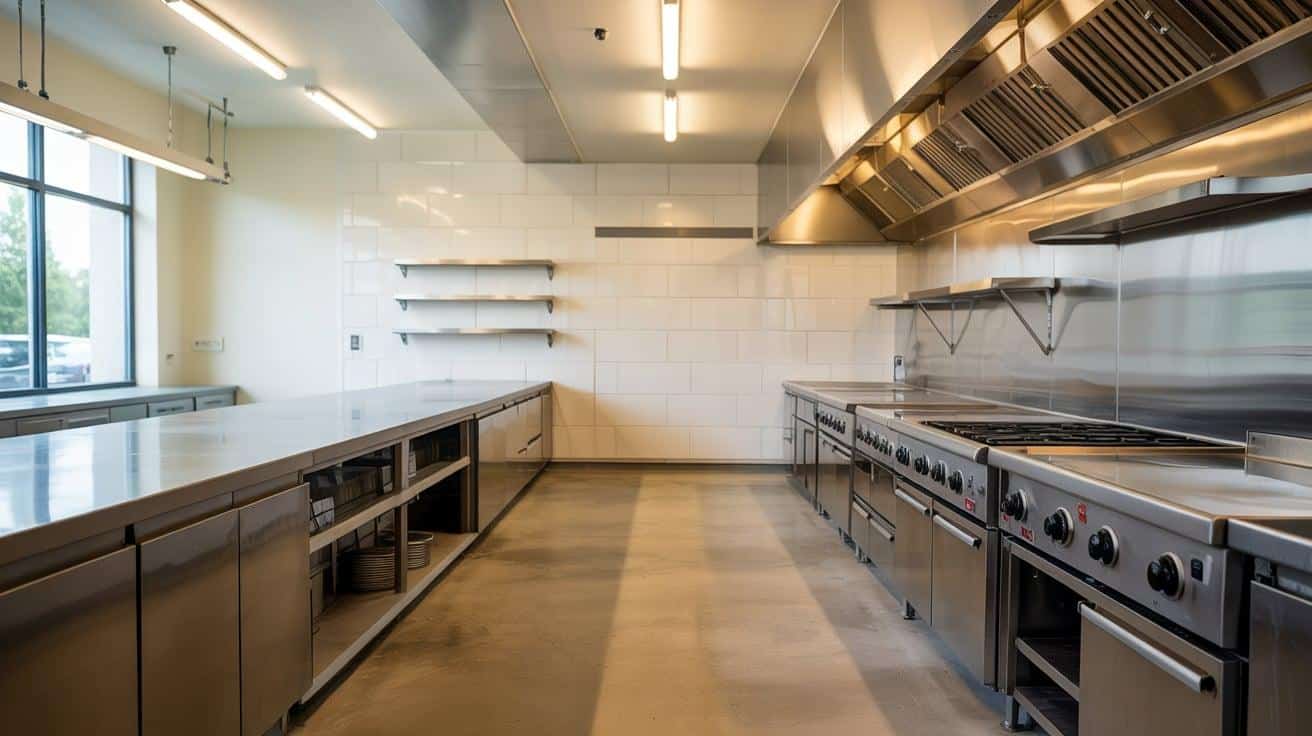
Concrete makes a strong base for commercial kitchens when properly sealed. Your existing slab can be treated with stains, dyes, or special coatings to create a food-safe surface that stands up to tough use.
Why choose concrete:
- Very strong under heavy equipment
- Easy to wash down at closing time
- Can be made to look modern and clean
- Long life when well-maintained
Things to consider:
- Very hard on staff’s feet and legs
- Needs texture or grit added for safety
Flooring Types to Avoid in Commercial Kitchens
| Flooring Type | Why to Avoid |
|---|---|
| Hardwood | Absorbs moisture, prone to warping, hard to sanitize |
| Laminate | Not water-resistant, can peel or swell, slippery when wet |
| Carpet | Traps dirt and bacteria, is tough to clean, and is not sanitary. |
| Unglazed Ceramic Tile | Slippery when wet, porous surface can harbor bacteria, and grout lines are hard to clean. |
Key Considerations for Commercial Kitchen Flooring

1. Slip resistance
Slip-resistant floors keep your team safe, even in the presence of grease and water spills. Look for flooring with texture or special grip features to enhance stability. Testing standards, such as the R-scale or coefficient of friction (COF), can help you make informed choices for your busy kitchen.
2. Durability under heavy use
Kitchen floors must withstand constant foot traffic, rolling carts, and dropped items. Good floors can withstand the weight of heavy pots, the sharpness of tools, and the daily strain of kitchen work. Check wear ratings and inquire about warranty terms before making a purchase.
3. Ease of cleaning & maintenance
Quick, simple cleaning saves time and keeps health inspectors happy. Look for floors with few seams and simple care instructions. Some options require only a mop, while others necessitate special cleaners or tools to maintain their good condition.
4. Moisture and heat resistance
Water, steam, and hot oil are common in kitchens, so your floor must be able to withstand them well. The right floor won’t warp, crack, or lose grip when wet. It should also withstand hot items that fall and resist stains from food spills.
5. Health and safety regulations
Food service floors must meet local health codes and safety rules. These often require non-absorbent materials and cove bases where floors meet walls. Check with health agencies to confirm your choice meets all legal standards.
6. Cost and installation factors
Consider both short-term and long-term costs when selecting a floor. Some options may cost more upfront but save money in the long run by lasting longer. Factor in how long the installation will close your kitchen, as this means lost income.
Regulations and Certifications to Consider When Choosing Flooring
| Standard | Description |
|---|---|
| Local Health Codes | Regulations set by local authorities ensure sanitation and safety in food prep areas. |
| OSHA Flooring Requirements | Guidelines to Prevent Workplace Hazards: Slips, Trips, and Falls. |
| NSF Certification | Certifies flooring materials as safe for food-contact environments, ensuring hygiene and non-toxicity. |
Conclusion
Choosing the right commercial kitchen flooring comes down to striking a balance between safety, functionality, and budget. Each option has its strengths and limitations that may work better for your specific needs.
Epoxy offers a seamless, tough surface that keeps things clean. Quarry tile withstands heat and heavy use for years. Vinyl gives comfort at a good price. Rubber helps tired feet, but may not last as long. Concrete provides a strong base that can be made safe with the right finish.
Think about what happens in your kitchen each day. How much foot traffic do you have? What spills are common? How often do you move heavy equipment? Let these questions guide your choice.
Remember that the best floor is one that staff can work on safely, cleans up quickly, and meets health regulations without incurring excessive costs over time. Take the time to test samples and consult with other kitchen owners before making your final decision.
What’s your next step in finding the perfect kitchen floor?
Frequently Asked Questions
How Often Should I Replace My Commercial Kitchen Floor?
Most quality commercial kitchen floors last 7-10 years, although this duration varies depending on factors such as foot traffic, maintenance, and the type of flooring chosen.
Can I Install New Flooring without Shutting Down My Kitchen?
Some contractors offer weekend or overnight installation, but most quality jobs require 2-5 days of kitchen closure for proper setting and curing time.
What’s the Best Flooring for Very Hot Climates?
For hot climates, consider flooring with thermal stability, such as quarry tile or sealed concrete, which won’t expand, contract, or soften under high temperatures.
How Do I Fix Small Cracks or Damage without Replacing the Entire Floor?
Small issues can be easily fixed with matching repair kits for vinyl and epoxy, while tile floors allow for the replacement of individual tiles without disturbing the entire surface.

